Kayak Vehicle
Having a kayak is only as good as your ability to get it to the lakes, rivers, and other waterways that you want to paddle on.
Without a proper vehicle to transport your kayak, you'll be stuck doing circles or mastering your Eskimo rolls in your backyard pool.
If you don't want to spend all your time in your kayak on dry land, you need to know how to transport your kayak safely. And while many kayakers tend to drive trucks or larger SUVs, there's no reason you can't transport a kayak on a small car.
Most kayaks these days don't weigh that much and they really aren't that hard to lift on top of your vehicle. And even the heaviest of kayaks on the market are much, much lighter than their heavy counterparts: the canoe.
But if you do have a small vehicle and you've recently purchased a kayak, it's imperative that you know how to transport a kayak on a small car safely.
Today, we'll provide you with multiple methods for transporting your kayak safely and also offer a few recommendations for the best small car kayak roof racks.
So let's hop in and paddle out!
Table of Contents
- 1 How To Transport A Kayak On A Small Car?
- 2 Methods For Transporting A Kayak On A Small Car
- 2.1 Towing A Small Kayak Trailer
- 2.2 Getting A Kayak Roof Rack
- 2.3 Strapping The Kayak To Your Roof Without A Rack
- 2.4 Sticking The Kayak In Your Car
- 3 How To Know If Your Kayak Is Too Big For Your Car
- 3.1 The Length Rule
- 3.2 Weight Limitations
- 4 Best Small Car Kayak Roof Racks
- 4.1 1. HandiRack Universal Inflatable Roof Rack Bars
- 4.2 2. Leader Accessories Folding Kayak Rack
- 4.3 3. WOOWAVE Kayak Carrier Deluxe Kit
- 5 Best Small Car Kayak Trailers
- 5.1 1. Malone MicroSport Sports Trailer
- 5.2 2. Ultra-Tow Aluminum Utility Trailer Kit
- 5.3 3. Malone MicroSport Trailer Two Kayak Transport Package
- 6 Final Thoughts
- 7 Enjoyed How To Transport A Kayak On A Small Car? Share it with your friends so they too can follow the Kayak Help journey.
- 7.1 Share on Pinterest
How To Transport A Kayak On A Small Car?
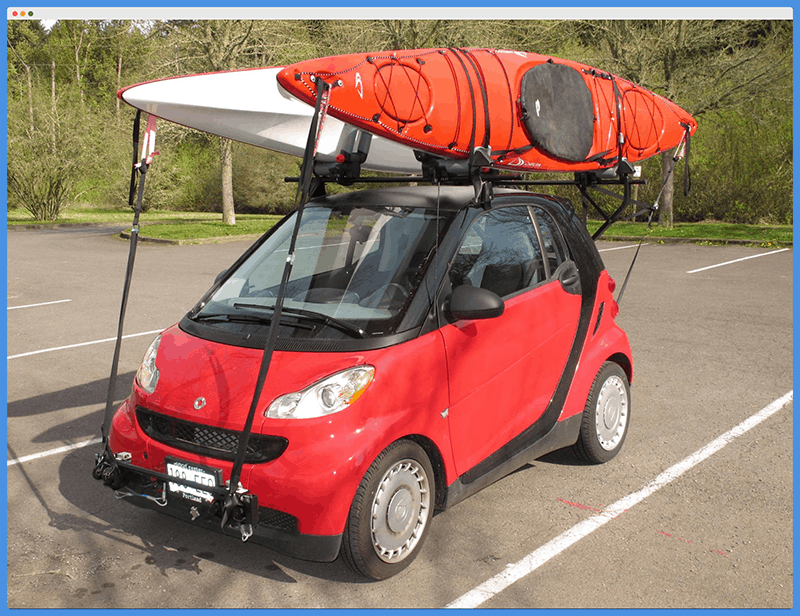
The honest truth is that there are several different ways to transport a kayak on a small car. You could get a roof rack, tow a kayak trailer, or figured out how to strap the kayak directly to your roof with cam straps.
Each of these methods requires careful considerations because failing to secure a kayak properly on any car could result in disastrous consequences. So let's dive deeper into the best methods for transporting a kayak on a small car!
Methods For Transporting A Kayak On A Small Car
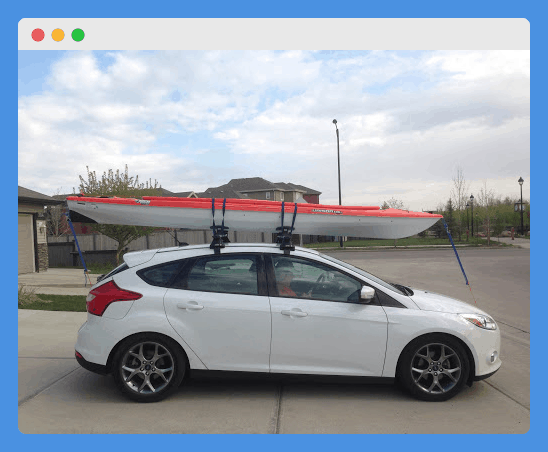
Over the years, we've seen a lot of creative ways of transporting kayaks on small vehicles, but there are several that stand the test of time better than others. These are our best recommendations for how to safely transport a kayak on a small car.
Towing A Small Kayak Trailer
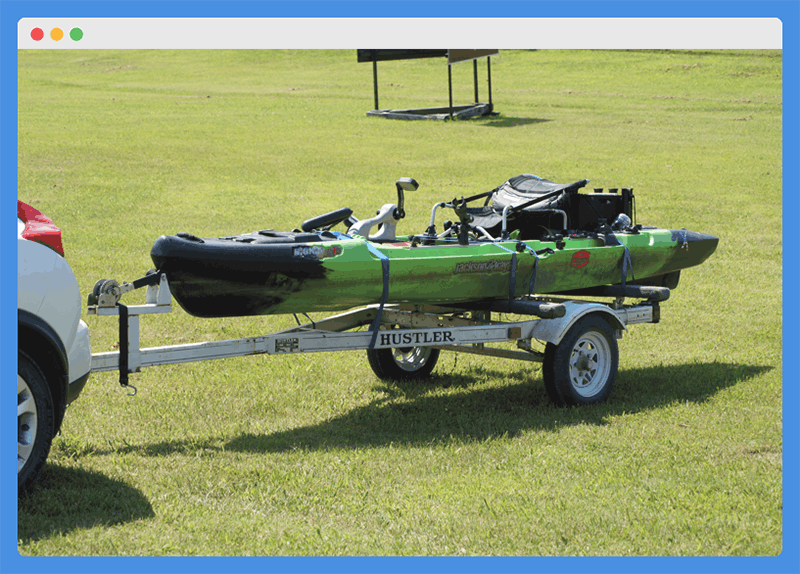
Even some smaller cars can tow a trailer with one or two kayaks on it if the trailer isn't too heavy.
Of course, your car will need to be equipped with a tow package and you'll need to make sure that the weight of the trailer and the kayak (or kayaks) that you load onto it doesn't exceed your vehicle's tow capacity.
But this is a great way to transport a kayak on a small car because it doesn't require you to lift the kayak up and over your head every time you are heading out for a paddle.
This means less likelihood of dropping the kayak and having it sustain damage when you're not even paddling.
It also reduces the effort you need to exert to transport your kayaks and minimize the strain on your back, knees, hips, and other joints. You'll only have to lift your kayak up to about the height of your hips to load it on most kayak trailers.
That being said, towing a kayak trailer behind a small car greatly reduces the amount of places you can park once you get to your paddling destination.
You'll be at least twice the length of your normal vehicle and that could mean you'll have to park further from where you want to put your kayaks in the water.
In some cases, however, it may be convenient for you to drop the trailer in one location and then take your vehicle on a run for supplies or last-minute gear. But that will still require extra work to couple and uncouple the trailer from your vehicle's hitch.
Getting A Kayak Roof Rack
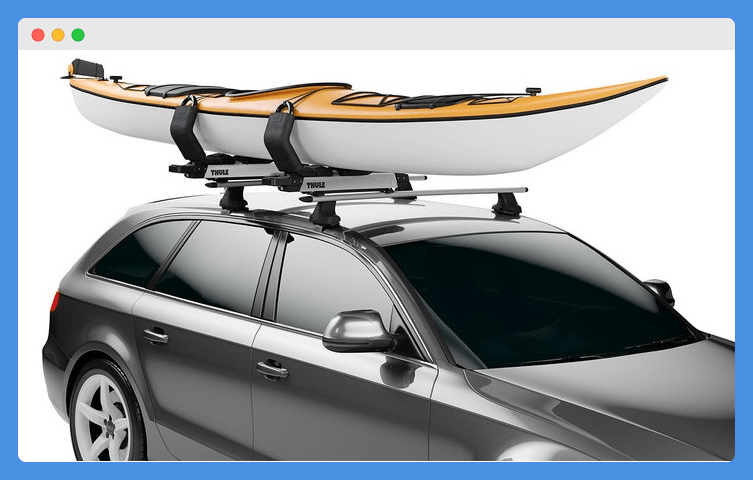
Perhaps the easiest and most secure way to transport a kayak on a small car is to purchase a kayak roof rack. Most of these racks, however, will require that you already have some sort of crossbars on the roof of your vehicle.
If you do, these racks are specially designed to make loading and strapping your kayak on the roof simple and easy.
Some of them even come with locking straps that help you guarantee the security of your kayak if you leave it strapped on the roof while you run into the grocery store.
Using a kayak rack to transport a kayak on a small car is also recommended because the kayak sits on the racks instead of directly on top of your vehicle. This helps to protect your car's paint job and also preserve the integrity of your kayak itself.
If you don't have crossbars, you'll need to explore another safe way to transport your kayak without a roof rack (more on that below!).
But if you do, or you're willing to get crossbars, we'd encourage you to read our article detailing how to strap a kayak to a roof rack properly.
Strapping The Kayak To Your Roof Without A Rack
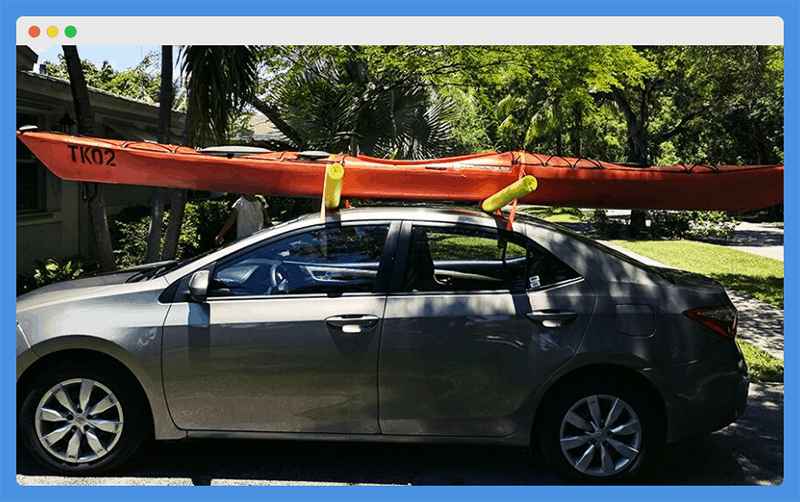
Many small cars don't come with crossbars or any sort of roof rack as a standard feature. The good news is that the lack of a roof rack shouldn't stop you from transporting a kayak on your car, but it does mean you'll have to know how to do it right.
Like the image above suggests, it's definitely possible to strap a kayak to the roof of a small car without a roof rack. When doing so, however, you should always make sure to place something between the roof and your kayak to provide insulation.
This kind of layer will prevent your kayak from rubbing or scratching against the paint on your car's roof.
This type of unprotected contact can damage both your vehicle and your kayak, so it should be avoided whenever transporting a kayak on the roof of a small car without a roof rack.
Pool noodles tend to be a great option for setting on top of your car between the roof and your kayak.
They are especially useful because they are hollow in the center, which allows you to thread a kayak cam strap directly through the noodle to create a de facto roof rack to set your kayak on.
There are several other techniques for strapping a kayak onto the roof of a car without a roof rack. So if this is the solution that you think you'll need to explore for transporting your kayak, check out this article on how to transport 2 kayaks without a roof rack.
Sticking The Kayak In Your Car
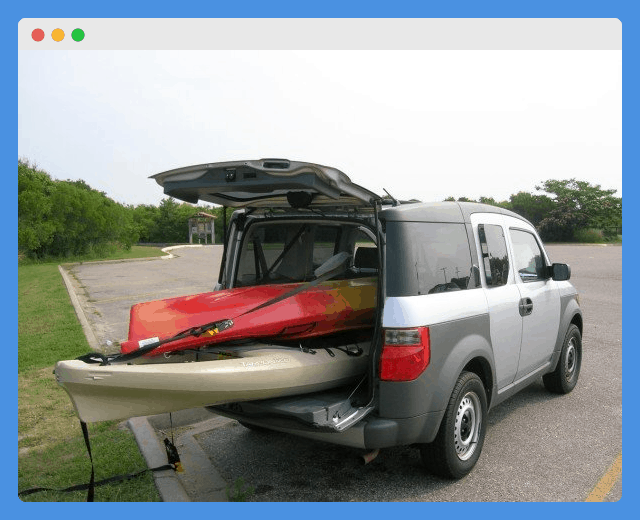
The final option we'll mention just briefly is loading your kayak so part of it sticks out of your car. This is certainly a possible technique for transporting a kayak on a small car, but it's also a surefire way to look like a kayaking newbie as you're going down the road and definitely when you pull into a launch location.
That being said, those of you with smaller kayaks may be able to load it into your vehicle so that only part of the kayak is sticking out of the back.
This will then require you to leave the tailgate or trunk of your car open while driving, which may or may not be comfortable depending on the outside temperatures where you live.
It will also require that you have adequate tie-down points in the trunk of your car so that you can attach cam straps that will keep the kayak from sliding out if you accelerate quickly or you're climbing up a steep hill.
Just to be clear about this method, we NEVER recommend loading a kayak into a car so that it sticks out sideways (as ridiculously seen below). Doing so presents a serious traffic hazard and is also sure to result in damage to your kayak, your vehicle, or both.

There is, however, the possibility that your kayak is far too long for this method to work because your kayak shouldn't stick too far out of the back of your vehicle. And that's exactly what we're going to discuss next!
How To Know If Your Kayak Is Too Big For Your Car
In rare cases, there is the possibility that the size of your kayak and the size of your vehicle are going to be incompatible. Here are a few tips to help you figure out if your kayak is too big for the car you're currently driving:
The Length Rule
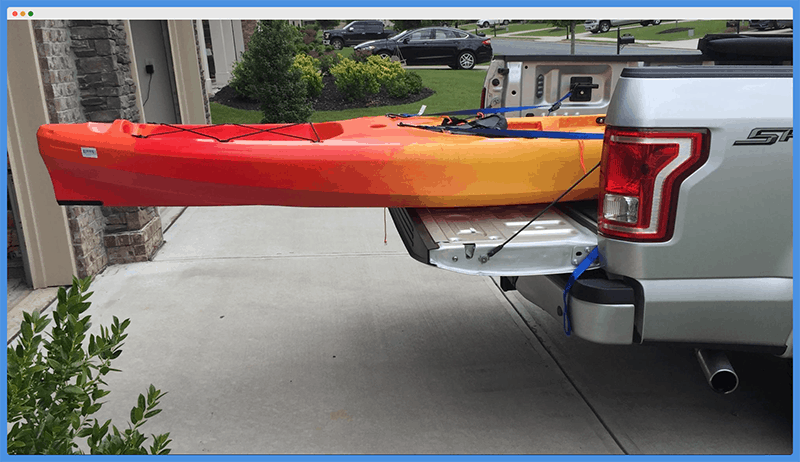
Generally speaking, small cars can transport long kayaks as long as you're using either a roof rack, kayak trailer, or strapping the kayak directly to the roof.
But if you're thinking about transporting your kayak so that it sticks out the back of your vehicle, there's a general rule of thumb to be aware of.
If more than half of your kayak is still sticking out of your vehicle once you try to load it in, it's too long! That will leave the majority of the kayak's weight unsupported and hanging out behind your vehicle, which will create an unsafe transporting situation.
Additionally, many states, counties, and local municipalities have their own regulations for safe towing and transportation, such as the requirement to hang a bright-colored flag from anything that extends past the back of your vehicle or trailer's bumper.
So be sure to check into those local laws and regulations before you settle on a method of transporting your kayak.
This will save you potential hassle down the line and help you avoid getting pulled over just trying to get to the water for your first paddle.
Weight Limitations

Even most small cars should be able to support the weight of a kayak with no issue. That's true for even some of the heaviest kayaks on the market, which typically don't exceed much more than 200 pounds.
That being said, kayaks that are that heavy are pretty rare and they mostly come in the form of fishing kayaks. If you do have a super-heavy fishing kayak, you'll more than likely be limited by your ability to lift it onto your car's roof rather than the actual weight capacity of that roof.
However, it will never hurt to check with your vehicle's manufacturer to make sure that the roof of your smaller car can support the weight of your kayak.
And if you do have a heavier kayak that you don't feel comfortable lifting onto the roof of your vehicle, we'd suggest looking into a small kayak trailer that you'll be able to tow safely behind you.
Title
HandiRack - The Original Universal Inflatable Roof Rack - Easy to Haul Kayaks, Canoes and Snowboards - Tie Down Straps and Bow and Stern Lines Included - 175 Pound Load Capacity - Fits Cars and SUVs
Leader Accessories Folding Kayak Rack 4 PCS/Set J Bar Car Roof Rack for Canoe Surf Board SUP On Roof Top Mount on SUV, Car and Truck Crossbar with 4 pcs Tie Down Straps
WOOWAVE Kayak Carrier Deluxe Carrier Kit Universal Soft Standard Foam Block for Roof Racks Car-Top Replacement with Tie-Downs, 12 inches
Malone MicroSport Sports Trailer for Kayaks, Canoes and Bikes
Thumbnail

Title
HandiRack - The Original Universal Inflatable Roof Rack - Easy to Haul Kayaks, Canoes and Snowboards - Tie Down Straps and Bow and Stern Lines Included - 175 Pound Load Capacity - Fits Cars and SUVs
Thumbnail

Title
Leader Accessories Folding Kayak Rack 4 PCS/Set J Bar Car Roof Rack for Canoe Surf Board SUP On Roof Top Mount on SUV, Car and Truck Crossbar with 4 pcs Tie Down Straps
Thumbnail

Title
WOOWAVE Kayak Carrier Deluxe Carrier Kit Universal Soft Standard Foam Block for Roof Racks Car-Top Replacement with Tie-Downs, 12 inches
Thumbnail

Title
Malone MicroSport Sports Trailer for Kayaks, Canoes and Bikes
Best Small Car Kayak Roof Racks
If you want to take the safe and steady route to transport a kayak on a small car, a roof rack is the way to go. So check out a few of these crossbar-mounted and roof-mounted small car kayak roof racks!
1. HandiRack Universal Inflatable Roof Rack Bars

This kayak roof rack solution is great for small cars that don't have crossbars or factory-mounted rails on the roof. And because it's an inflatable solution, it will take up minimal space in your trunk when you're not using it.
The HandiRack system comes with two pads that inflate and secure to the roof of your vehicle. Once set up, this system can support kayaks up to 175 pounds and is certified for safe use at typical highway speeds.
As their name suggests, this is truly a universal kayak rack solution. You'll be able to install the racks on any vehicle of your choosing and your vehicle won't need side rails or gutters to help secure the rack in place.
Once you set the racks in place on your roof, the straps pass through the doors of your vehicle and tighten down using a heavy-duty cam strap. And the cool part about this kayak roof rack is that it comes with its own high-volume HandiPump to help you easily inflate the bladders before placing them on your roof.
2. Leader Accessories Folding Kayak Rack

This is a suitable kayak rack solution if your vehicle already has crossbars installed on the roof. And unlike the HandiRack (which should be removed after each use), these racks can be installed and permanently remain attached to your crossbars if you desire.
That's because they fold down when you're not using them so that they don't cause extra wind resistance and reduce the fuel efficiency of your vehicle. It also means that you don't have to worry about passing under any low branches and hitting these racks on them when you're not transporting a kayak.
But getting your kayak onto these racks is also super easy because of their J-shaped design. That's why many single paddlers choose J-racks because they allow you to lift one side of your kayak at a time instead of having to support its full weight all at once (more on how to load kayaks onto J-racks here!).
And the best part about this specific rack solution is that it actually comes as a four-piece set. This means you'll be able to transport two kayaks at a time and each can be up to 100 pounds in weight!
3. WOOWAVE Kayak Carrier Deluxe Kit

The WOOWAVE Kayak Carrier Deluxe Kit is also a great solution for transporting a single kayak on a small car. You won't be able to transport two kayaks with this solution, but it will be easier to set up because there's no inflation necessary.
Instead, you'll simply need to place the two foam blocks about 36 to 48 inches apart on top of your car. Then, you'll thread the included cam straps through the slots on the bottom of the foam blocks and run them through the doors of your vehicle.
The straps tighten together using the cam-locking style and that secures the blocks to the roof of your vehicle. Of course, you will need an extra set of cam straps to secure your kayak down once you load it onto the blocks, but this carrier kit does come with guy lines for securing the bow and stern of your kayak.
This kayak carrier kit works on small cars with or without side rails and it provides excellent cushion for your kayak as you're bumping down the road. The blocks themselves are made of EVA foam with a non-skid grip on the bottom to keep them securely in place when installed properly.
Best Small Car Kayak Trailers
If your small vehicle has a towing package on it and you like the idea of loading kayaks onto a hip-height trailer instead of a head-high vehicle, then check out some of these small car kayak trailer options!
1. Malone MicroSport Sports Trailer
This is a great solution for small car owners that want the ability to transport enough kayaks to get the whole family out on the water. You'll be able to load up to four kayaks on this trailer and it offers a maximum load capacity of 800 pounds.
It's also capable of supporting kayaks up to 20 feet long and the 60-inch steel crossbars are still narrower than the width of most compact cars. The entire trailer weighs 132 pounds, but the hitch weight is much less than that.
This trailer actually ships to you in multiple pieces, which means you'll need to fully assemble it once it arrives. Be aware that the assembly process for this trailer can require two or three hours, but it does come with a complete set of instructions for easy assembly.
2. Ultra-Tow Aluminum Utility Trailer Kit
Despite its more compact dimensions, the Ultra-Tow Aluminum Utility Trailer Kit actually boasts quite the load capacity. You can carry up to 1,060 pounds on this trailer, but you should make sure the towing capacity of your vehicle is at least 1,200 pounds before fully loading this trailer.
That said, it may be an excellent solution for transporting fishing kayaks behind small cars because that type of kayak tends to be shorter but heavier. And with the 40-inch long and 48-inch wide bed on this trailer, you can even strap multiple kayaks down to go kayak fishing with a buddy.
The frame of the Ultra-Tow trailer is fully aluminum, which is rustproof for use in salty or humid conditions. The total weight of the trailer itself is 135 pounds, and you should always be sure to attach the trailer to your vehicle before loading kayaks onto it.
3. Malone MicroSport Trailer Two Kayak Transport Package
The Malone MicroSport Trailer Two Kayak Transport Package is a fully-equipped solution for you and your partner's kayaks. The trailer comes with two sets of Malone SeaWing kayak carriers for even easier loading and unloading of your kayaks.
It's rated to carry kayaks up to 18 feet long and it also boasts 60-inch aluminum cross rails like the standard MicroSport Trailer. But having dedicated V-shaped racks for your kayaks makes them so much easier to load on and strap down.
The trailer weighs a total of 240 pounds, however, so it should always be moved with a partner when uncoupling from your small car. And don't forget to budget two to three hours to assemble the trailer completely once it arrives!
Final Thoughts
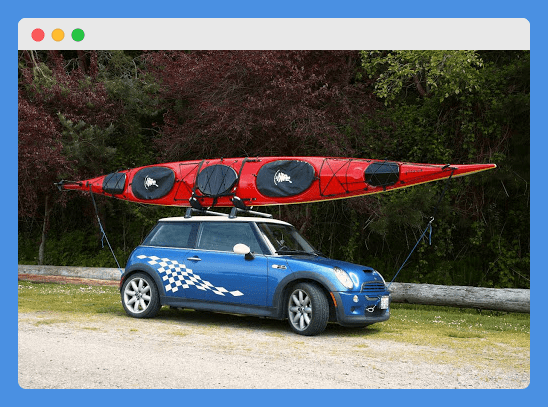
Some kayaks aren't the smallest of investments to make if you're just getting into the sport. A kayak that costs hundreds of dollars should be cared for and protected throughout its lifetime, and that's especially important when you're transporting it.
With these methods and tips for how to transport a kayak on a small car, you'll be able to make the most out of the investment you've made into a new kayak for years to come.
And we hope you practice safe kayak transportation wherever the long and winding road (or waterway) takes you in the future!
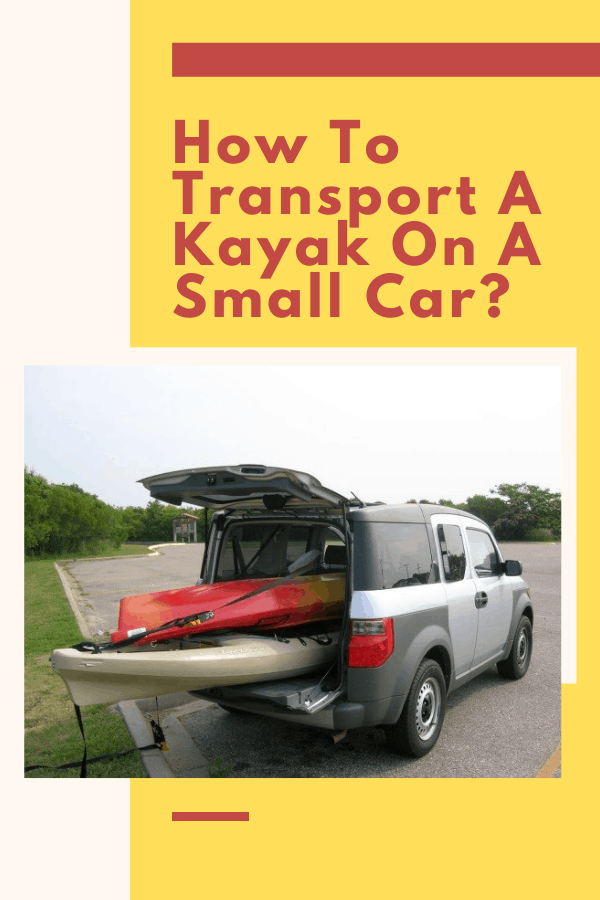

Author: Peter Salisbury Pete is the Owner of KayakHelp.com. Born and raised in Cleveland, Ohio, he grew up kayaking, fishing, sailing, and partaking in outdoor adventures around the Great Lakes. When he's not out on the water, you can find him skiing in the mountains, reading his favorite books, and spending time with his family.
Source: https://www.kayakhelp.com/how-to-transport-a-kayak-on-a-small-car/

0 komentar:
Posting Komentar